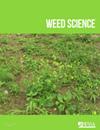Evaluation of organic options for Johnsongrass (Sorghum halepense) control during winter fallow
IF 2.1
2区 农林科学
Q2 AGRONOMY
引用次数: 0
Abstract
Johnsongrass [Sorghum halepense (L.) Pers.] is one of the most problematic perennial grass weed species in row-crop production across the southern United States. Control of this species is especially challenging in organic systems due to a lack of effective options. A field experiment was conducted at the Texas A&M research farm near College Station, TX, from fall 2019 to spring 2021 to evaluate various nonchemical options for managing S. halepense in the fallow season, implemented over 2 yr in the same locations. The treatments included disking once, disking twice, disking + immediate flooding, disking + flush irrigation + flooding, disking twice + flooding after the first frost, periodic mowing, acetic acid treatment, and disking + tarping. Disking + immediate flooding, disking + flush irrigation + flooding, and disking + tarping were the most effective treatments. Compared with the nontreated control plots, these treatments reduced S. halepense aboveground density (<9 plants m−2 vs. 64 plants m−2), aboveground biomass (<80 g m−2 vs. 935 g m−2), rhizome biomass (<4 g m−2 vs. 55 g m−2), rhizome node number (<25 nodes m−2 vs. 316 nodes m−2), and rhizome length (<42 cm m−2 vs. 660 cm m−2). Disking twice + flooding after the first frost did not show a consistent impact. Periodic mowing also reduced S. halepense density (12 plants m−2 vs. 64 plants m−2) and other variables compared with the control plots at the end of the study in spring 2021. Disking alone once or twice each growing season or repeated application of acetic acid failed to control S. halepense. These results indicate that well-timed nonchemical management practices such as tarping and flooding implemented during the winter fallow can be very effective in reducing S. halepense densities.评估冬季休耕期间控制约翰逊草(高粱)的有机方案
约翰逊草[Sorghum halepense (L.) Pers.]是美国南部行作物生产中问题最大的多年生禾本科杂草之一。由于缺乏有效的选择,在有机系统中控制这种杂草尤其具有挑战性。2019 年秋季至 2021 年春季,在德克萨斯州学院站附近的德州农工大学研究农场进行了一项田间试验,以评估在相同地点实施 2 年以上的各种非化学方法来管理休耕期的 S. halepense。处理方法包括打盘一次、打盘两次、打盘+立即灌水、打盘+冲灌+灌水、打盘两次+初霜后灌水、定期除草、醋酸处理以及打盘+铺柏油。打盘+立即灌水、打盘+冲灌+灌水和打盘+铺柏油是最有效的处理方法。与未处理的对照地块相比,这些处理方法降低了黑麦草的地上部密度(<9 株 m-2 vs. 64 株 m-2)、地上部生物量(<80 克 m-2 vs. 935 克 m-2)、根茎生物量(<4 克 m-2 vs. 55 克 m-2)、根茎节数(<25 节 m-2 vs. 316 节 m-2)和根茎长度(<42 厘米 m-2 vs. 660 厘米 m-2)。第一次霜冻后除草两次并灌水的影响并不一致。在 2021 年春季研究结束时,与对照地块相比,定期除草也降低了哈雷滨草的密度(12 株 m-2 对 64 株 m-2)和其他变量。每个生长季单独除草一到两次或重复施用醋酸都无法控制沙棘。这些结果表明,在冬季休耕期间适时采取非化学管理措施,如铺柏油和灌水,可以非常有效地降低沙棘的密度。
本文章由计算机程序翻译,如有差异,请以英文原文为准。
求助全文
约1分钟内获得全文
求助全文
来源期刊

Weed Science
农林科学-农艺学
CiteScore
4.60
自引率
12.00%
发文量
64
审稿时长
12-24 weeks
期刊介绍:
Weed Science publishes original research and scholarship in the form of peer-reviewed articles focused on fundamental research directly related to all aspects of weed science in agricultural systems. Topics for Weed Science include:
- the biology and ecology of weeds in agricultural, forestry, aquatic, turf, recreational, rights-of-way and other settings, genetics of weeds
- herbicide resistance, chemistry, biochemistry, physiology and molecular action of herbicides and plant growth regulators used to manage undesirable vegetation
- ecology of cropping and other agricultural systems as they relate to weed management
- biological and ecological aspects of weed control tools including biological agents, and herbicide resistant crops
- effect of weed management on soil, air and water.
 求助内容:
求助内容: 应助结果提醒方式:
应助结果提醒方式:


